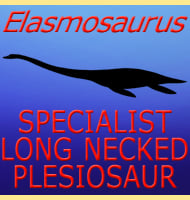Elasmosaurus
In Depth Today Elasmosaurus is one of the best known plesiosaurs in the world, and is the type genus for the Elasmosauridae. This group is noted for having particularly long necks, proportionately even longer than the more standard plesiosaurs. These long necks are composed of a large number of cervical vertebrae that in Elasmosaurus number … Read more
